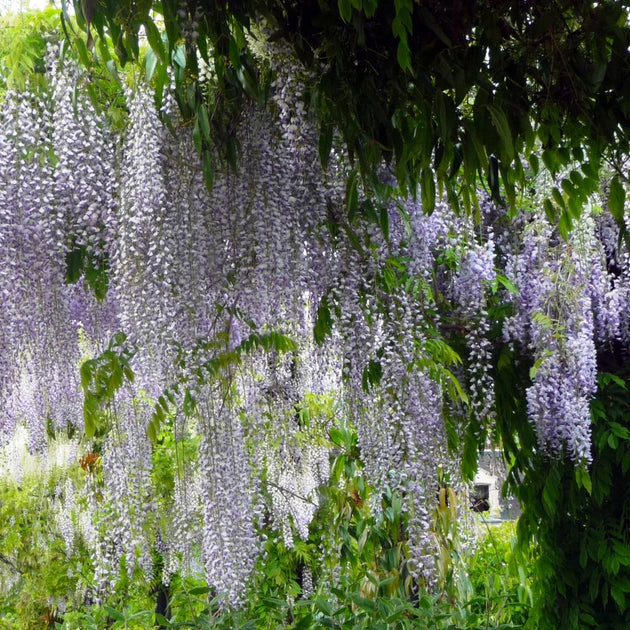
Wisteria floribunda 'Multijuga' Tree
Wisteria floribunda 'Multijuga' Tree
Japanese Lilac Wisteria

Wisteria floribunda 'Multijuga' Tree
Japanese Lilac Wisteria

Key features





Description
Wisteria floribunda 'Multijuga' is renowned for long recemes of beautiful lilac flowers that hang down gracefully. Racemes measuring 1 metre in length have been spotted in the UK and in Japan they are known to grow even longer! The sweetly scented flowers are violet with darker purple markings and appear as the vibrant green leaves emerge in spring.
Growing well in sun or partial sun, Wisteria 'Multijuga' prefers moist, well-drained soil. We think it is best grown against a sunny wall using support wires, trained over a pergola or above a window so the racemes can be enjoyed from inside. Multijuga can also be trained (using a tree stake) as a freestanding Wisteria tree. This variety can be grown to 8 x 10 metres in 20 years or kept much smaller.
It is no surprise 'Multijuga' holds the RHS Award of Garden Merit and as our Wisteria are grafted, they tend to flower younger than those grown from cuttings.
AKA Wisteria floribunda Macrobotrys, Japanese Climbing Wisteria, Lilac Wisteria
| Small shrubs (1-3) | Young trees & 4+ small shrubs | Select semi-mature trees & shrubs (1-4) | All other mature trees (any quantity) | |
|---|---|---|---|---|
| Mainland UK ex. Scottish Highlands | £10 | £12 | £35 | from £55 |
| Scottish Highlands & the Islands | From £30 | |||
| Outside Mainland UK | Currently we are unable to deliver outside of Mainland UK | |||
Product Details
Key features





Description
Wisteria floribunda 'Multijuga' is renowned for long recemes of beautiful lilac flowers that hang down gracefully. Racemes measuring 1 metre in length have been spotted in the UK and in Japan they are known to...
Wisteria floribunda 'Multijuga' is renowned for long recemes of beautiful lilac flowers that hang down gracefully. Racemes measuring 1 metre in length have been spotted in the UK and in Japan they are known to grow even longer! The sweetly scented flowers are violet with darker purple markings and appear as the vibrant green leaves emerge in spring.
Growing well in sun or partial sun, Wisteria 'Multijuga' prefers moist, well-drained soil. We think it is best grown against a sunny wall using support wires, trained over a pergola or above a window so the racemes can be enjoyed from inside. Multijuga can also be trained (using a tree stake) as a freestanding Wisteria tree. This variety can be grown to 8 x 10 metres in 20 years or kept much smaller.
It is no surprise 'Multijuga' holds the RHS Award of Garden Merit and as our Wisteria are grafted, they tend to flower younger than those grown from cuttings.
AKA Wisteria floribunda Macrobotrys, Japanese Climbing Wisteria, Lilac Wisteria
Planting & Care
Delivery Information
| Small shrubs (1-3) | Young trees & 4+ small shrubs | Select semi-mature trees & shrubs (1-4) | All other mature trees (any quantity) | |
|---|---|---|---|---|
| Mainland UK ex. Scottish Highlands | £10 | £12 | £35 | from £55 |
| Scottish Highlands & the Islands | From £30 | |||
| Outside Mainland UK | Currently we are unable to deliver outside of Mainland UK | |||
MORE TO GROW YOUR GARDEN











